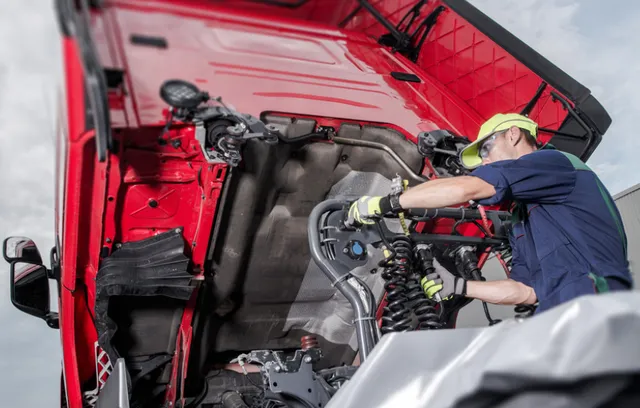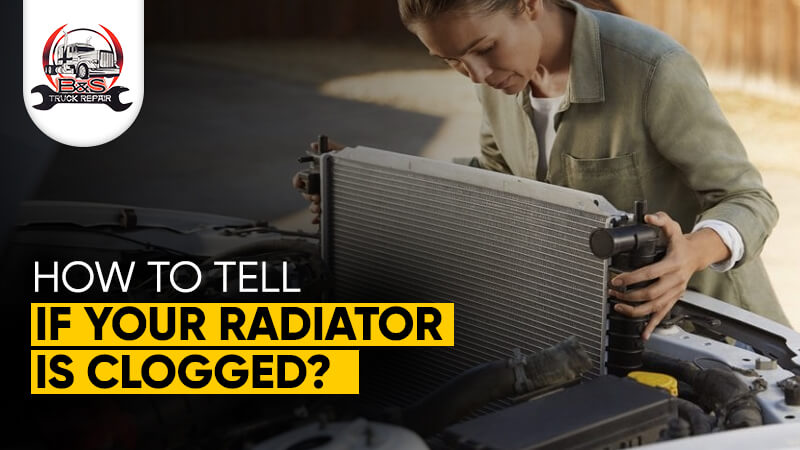Maintaining the coolant level in your truck’s engine depends on a functioning radiator. The accumulation of dirt or rust in the radiator can cause issues such as engine overheating, decreased performance, and costly repairs. In this post, we’ll examine the typical symptoms of a clogged radiator in diesel trucks as well as the procedures you may take to identify and resolve the problem. As skilled heavy-duty truck mechanics at B&S Truck Repairs, we frequently observe broken or leaking radiators, giving truck owners issues. Early detection of radiator issues is essential to preventing future malfunctions and expensive repairs. Continue reading to discover how to recognize the signs of a blocked radiator and whether radiator replacement or repair is necessary for your truck.
Top Common Radiator Issues in Truck
Among the most frequent radiator issues in diesel trucks is a clogged radiator. Additional concerns consist of detectable coolant leaks from unsecured connections or fissures in the material. Degradation from roadway debris lowers the cooling effectiveness of the radiator fins. Inside the radiator, mineral deposits accumulate over time and cause internal scaling, which impedes flow. Broken radiator mounts might result in excessive vibration-induced cracking or leaking.
How Do I Know If My Radiator Is Bad?
Look out for these signs of a blocked radiator to find out if the radiator on your truck needs to be repaired:
- Heat exhaustion engine: When an engine overheats frequently while driving, especially while stopped in traffic, it is the most unambiguous indication that the radiator is clogged.
- Insufficient coolant levels: Having to top off the coolant frequently indicates a leak brought on by a malfunctioning radiator.
- Cloudy oil: The engine fluid turns milky due to a coolant mixture facilitated by an engine head gasket leak.
- White smoke or vapor from the engine compartment under the bonnet indicates that the coolant is boiling over from overheating.
- Temperature gauge rising: When driving, keep an eye out for any indications of overheating on the heat monitor.
Can I Drive With a Cracked Radiator?
Operating a vehicle with a broken or damaged radiator is severely discouraged. A little crack might still allow for some performance, but there’s a possibility of major overheating problems and a fast deterioration. Our team of experts in Diesel Engine Repair suggests fixing or replacing a fractured radiator right away to prevent roadside breakdowns and vehicle damage.
What Causes a Radiator to Overheat in a Truck?
Typical causes of diesel truck radiator overheating include:
- Rust, debris, and mineral accumulations obstructing coolant flow are known as clogged tubes.
- Broken fans: Air cannot cool the radiator core through bent fins.
- Leakage within the radiator: Any leak, whether internal or external, lowers the coolant level and causes overheating.
- A malfunctioning thermostat might impede the correct coolant circulation by being stuck closed.
- A malfunctioning water pump cannot sufficiently circulate the engine coolant.
When to Replace Radiator?
Consider replacing your truck’s radiator if you observe several cracks and leaks. Right now, it isn’t worth fixing. Severe scaling and rust inside. Blockages cannot be removed by flushing. Approximately 40% of the surface is covered in bent fins. decreases the ability to cool. Older than 8 to 10 years old. Over time, radiators deteriorate. Problems with overheating continue after repairs or flushing. indicates harm that cannot be repaired. As a Heavy Duty Truck Engine Mechanic Specialist, we can advise whether you should replace the cooling system or pursue additional repairs.
How to Test Radiator for Blockage?
If the radiator in your truck is obstructed or blocked, there are a few easy tests you may do at home. The flow test is carried out by feeling the top and bottom radiator hoses once the engine has reached operating temperature. With warm fluid leaving the engine through the top pipe and colder coolant returning to the engine through the bottom line, there ought to be a discernible temperature differential between the two hoses. There may be a radiator flow limitation if one hose feels noticeably hotter while the other stays cool.
Infrared energy colorants and pressure testing methods can be used for more conclusive testing. Get a radiator pressure tester kit to determine the pressure level on either side of the radiator. A blockage impedes appropriate coolant flow if the pressure differential between the top and bottom ports is excessive, more than 15 psi. Start the engine after adding fluorescent dye to the radiator system. You can use a UV light examination to look for any flow obstructions where the dye doesn’t get through the radiator. Lastly, areas of decreased circulation caused by debris blockages within the radiator core can be identified by cooler zones detected by a thermometer with infrared wavelengths pointed at the radiator surface. These advanced exams call for a little extra work.
Symptoms of a Partially Clogged Radiator
The following are indications of a partially clogged radiator:
- The temperature of the engine is high at idling but normalizes as speed increases.
- The heater is not always working.
- The temperature gauge for the engine is higher than usual.
- usually need to top out the coolant.
- odor caused by coolant leakage.
- inside the cab, less heat.
- vapor from the overflow reservoir.
Choose Best Truck Repair Shop For Your Truck Today!
- Affordable
- Quick Fix
- Boost Truck Performance

How to Unclog a Radiator?
Radiator unclogging techniques include:
- Cleaning away deposits and debris with a radiator wash chemical and water is called flushing.
- Rodding clears obstructions in the fins and tubes using a radiator rodder tool.
- Using a hose to force water through the radiator in the opposite direction is reverse flushing.
- Compressed air: To loosen material that has become lodged, air with high pressure is forced through the radiator.
- Chemical descaling: Mineral deposits and corrosion are removed with radiator cleaner chemicals.
After any unclogging procedure, give your radiator a good rinse and dry. Replace may be necessary if obstructions are severe. Our skilled Diesel Engine Repair specialists can identify the most effective way to clear the radiator in your truck.
Conclusion
It’s critical to identify radiator issues early on to prevent being stuck on the side of the road or needing expensive repairs due to engine damage. Learn to keep an eye out for signs of radiator problems, such as steam coming from under the hood, leaks of fluid, and overheating. You can determine if your radiator is partially or completely clogged with easy testing. For mild clogs, flushing, rodding, or back flushing are frequently effective methods; for severe situations, radiator replacement is necessary. At B&S Truck Repairs have skilled Heavy Duty Truck Engine Mechanic Specialists with the knowledge and expertise to identify radiator issues and suggest the best fixes to keep your vehicle operating safely. If you think your radiator requires maintenance, get in touch with us right now to arrange for service.

